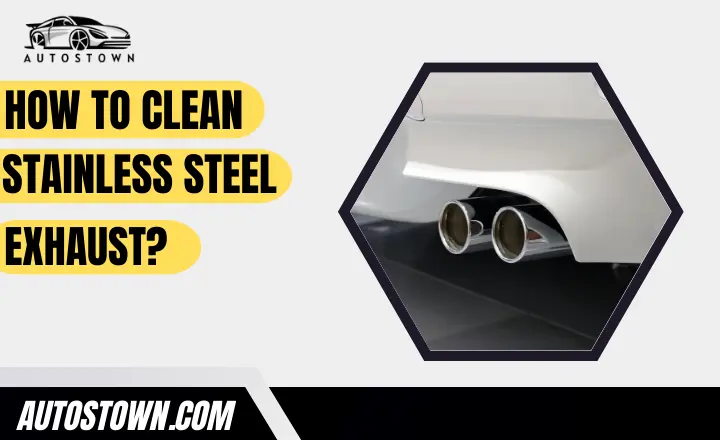Stainless steel exhausts are not only a necessary component of our automobiles, but they also give them a sleek and sophisticated appeal. However, even gleaming surfaces can get tarnished with dirt, filth, and persistent stains that appear hard to remove over time. Not to worry! This article will look at five efficient methods for restoring the luster and gloss to your stainless steel exhaust and how to clean stainless steel exhaust. With these easy yet effective strategies at your disposal, you’ll be able to keep your vehicle’s perfect appearance while assuring maximum performance from its exhaust system. So let’s get started and learn how to get a pristine stainless steel exhaust!
Why Stainless Steel Exhausts Need Regular Cleaning
- 1. Over time, the accumulation of dirt, road filth, and oil deposits on stainless steel exhausts can cause the metal to degrade. You can prolong the exhaust system’s life and keep it operating at its best by routinely cleaning it to stop rust and corrosion from developing.
- 2. Not cleaning your stainless steel exhaust might result in restricted airflow from carbon and soot accumulation, which lowers your car’s power production and fuel economy. Frequent cleaning guarantees maximum engine performance in addition to keeping your exhaust looking great.
- 3. By thoroughly cleaning the exhaust components, you can check for wear or corrosion and identify problems early on before they become more serious and require expensive repairs or replacements.
- 4. A stainless steel exhaust system that is not properly maintained may tarnish or discolor, which will reduce the vehicle’s aesthetic attractiveness. Regular maintenance will keep your car’s exterior and overall performance looking as good as new.
- 5. Toxic fumes from untended exhaust buildup represent a health concern to neighboring air when driving and significantly reduce emission levels.
- 6. Continual sanitation Its beautiful brilliance may be restored and hard residues removed with simple steps like washing with mild soap and polishing, which also ensures constant protection from the weather.
How to Clean Tarnished Stainless-Steel Exhaust It
Cleaning tarnished stainless-steel exhaust might be difficult, but you can restore its sheen and beauty with the appropriate techniques.
Step 1: Turn the Car Off
Turn off the automobile. It is critical to begin the cleaning process when the exhaust has completely cooled. Cleaning a hot exhaust can result in burns or injuries, so proceed with caution and allow it to cool first.
Step 2: Power Wash Outside Dirt
A strong pressure washer fitted with an appropriate nozzle attachment may effectively blast away any leftover residue and restore the luster of your exhaust system.
Pay particular attention to locations where dirt and impurities are prone to accumulate, such as seams, joints, and crevices, while you power wash the exterior of the exhaust.
Step 3: Get Sponge Brush & Polish
Polish your sponge brush. After allowing the vinegar solution to work its magic on the tarnished stainless-steel exhaust, scrub it well. Scrub the surface of the exhaust with a sponge brush with soft bristles, focusing on places with hard tarnish. The sponge brush will aid in the removal of any lingering filth and dirt, leaving your exhaust looking gleaming and brand new.
Step 4: Start Applying the Cleaning Item
Put the Cleaning Item to Use. It’s time to begin applying the cleaning solution to the exhaust now that it has been prepared. Stainless steel cleaners, meguiars liquid cleaner or dish soap diluted with warm water are good options. Working on a tiny section at a time, apply the solution in circular motions with a delicate cloth. This guarantees complete coverage and enables the tarnish or filth to be effectively broken down by the cleaning.
Step 5: Make Sure You Cover Every Corner
Making sure you get into every crevice of the tarnished stainless-steel exhaust is essential after applying the cleaning solution and letting it sit for a few minutes. Inside curves, cracks, and concealed places that might gather dirt over time are frequently disregarded regions. These hard-to-reach areas can be partially cleaned by using an old toothbrush or soft-bristled brush in conjunction with the cleaning solution. You can guarantee a comprehensive and efficient cleaning procedure by focusing on these frequently overlooked regions.
Step 6: Clean Up Inside the Exhaust
The sixth step, which is cleaning the exhaust’s interior, is frequently missed but is crucial for a complete cleaning. To remove any accumulated dirt or residue, use a pipe cleaner or brush with a long handle and a solution of baking soda and water. This step not only makes your exhaust look better overall, but it also guarantees good airflow and peak performance.
Step 7: Use A Polishing Kit
An excellent metal polishing kit made specifically for stainless steel will do wonders for your exhaust’s luster and sheen. Usually included in these packages are buffing pads and abrasive substances for removing tough stains and discolorations. Through proper use of the kit’s instructions, you may polish your exhaust system’s surface back to its former brilliant state.
How Often Should You Clean Steel Exhaust
The amount of fuel consumed, driving patterns, and environmental factors all affect how often a vehicle needs to be cleaned. In urban regions with mild driving conditions, a thorough cleaning every six to twelve months is usually sufficient for everyday commuters.
However, more frequent cleaning every three to 6 months may be required for individuals who live in high-traffic or industrial regions, or for off-road enthusiasts, to prevent the building of dangerous residues. By monitoring the exhaust’s appearance and smell, one can detect when maintenance is necessary and take preventative action instead of waiting for problems to arise.
How Long Does A Stainless Steel Exhaust Last
The answer is dependent on some factors, including the quality of the stainless steel used in the exhaust system’s design, the amount of maintenance and care given to it, and the environment in which it runs. A well-kept stainless steel exhaust may easily last 10-15 years or even longer if properly maintained. Some owners have stated that with good maintenance and frequent checks for possible concerns like cracks or leaks, their stainless steel exhausts may last up to 20 years.
Poor maintenance procedures or exposure to hostile environments can dramatically diminish the lifespan of a stainless steel exhaust. Aggressive driving patterns, such as repeated high-speed drives or regular off-roading activities, can place undue strain on exhaust system components, thereby causing early wear and tear. As a result, while stainless steel is incredibly durable when utilized appropriately in an ideal situation with adequate upkeep, bear in mind that taking care of your vehicle is critical in guaranteeing its durability.
Conclusion
Keeping the gloss of your stainless steel exhaust is critical to not just maintaining its beauty but also extending its longevity. By cleaning and polishing the surface regularly, you can avoid the accumulation of dirt, grime, and rust, which can eventually lead to corrosion and damage. Furthermore, employing the proper cleaning products and procedures helps protect the stainless steel finish and any surrounding components.
Remember to follow the manufacturer’s instructions and think about investing in protective coatings for enhanced durability. With regular care, your stainless steel exhaust will continue to improve the appearance of your vehicle for many years. Begin applying these maintenance procedures right away to enjoy a dazzling exhaust system that shines out on the road.
FAQs:
1. What causes stainless steel exhaust to lose its shine over time?
– Exposure to dirt, grime, and environmental elements can cause stainless steel exhaust to lose its shine.
2. Is it necessary to clean stainless steel exhaust regularly?
– Yes, regular cleaning is essential to maintain the shine and longevity of your stainless steel exhaust.
3. How often should I clean my stainless steel exhaust?
– It is recommended to clean your stainless steel exhaust at least once a month or as needed based on its usage and exposure.
4. Can I use any household cleaner to clean my stainless steel exhaust?
– No, using harsh chemicals or abrasive cleaners can damage the surface of your stainless steel exhaust. Use specially formulated stainless steel cleaners instead.
5. How do I remove stubborn stains or discoloration from my stainless steel exhaust?
– You can try using a mixture of water and mild dish soap along with a soft cloth or sponge to gently scrub away stubborn stains. Avoid using abrasive materials or scrubbing too hard.

